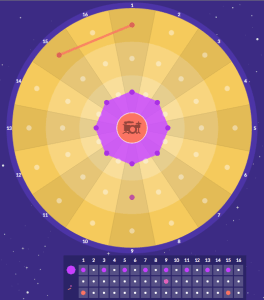In a previous post, I used the Groove Pizza to visualize some classic hip-hop beats. But the kids are all about trap beats right now, which work differently from the funk-based boom-bap of my era.

From the dawn of jazz until about 1960, African-American popular music was based on an eighth note pulse. The advent of funk brought with it a shift to the sixteenth note pulse. Now we’re undergoing another shift, as Southern hip-hop is moving the rest of popular music over to a 32nd note pulse. The tempos have been slowing down as the beat subdivisions get finer. This may all seem like meaningless abstraction, but the consequences become real if you want to program beats of your own.
Back in the 90s, the template for a hip-hop beat looked like a planet of 16th notes orbited by kicks and snares. Click the image below to hear a simple “planet funk” pattern in the Groove Pizza. Each slice of the pizza is a sixteenth note, and the whole pizza is one bar long.

(Music readers can also view it in Noteflight.)
You can hear the sixteenth note hi-hat pulse clearly in “So Fresh So Clean” by OutKast.

View in Noteflight
Trap beats have the same basic skeleton as older hip-hop styles: a kick on beat one, snares on beats two and four, and hi-hats on some or all of the beats making up the underlying pulse. However, in trap, that pulse is twice as fast as in 90s hip-hop, 32nd notes rather than sixteenths. This poses an immediate practical problem: a lot of drum machines don’t support such a fine grid resolution. For example, the interface of the ubiquitous TR-808 is sixteen buttons, one for each sixteenth note. On the computer, it’s less of an issue because you can set the grid resolution to be whatever you want, but even so, 32nd notes are a hassle. So what do you do?
The trap producer’s workaround is to double the song tempo, thereby turning sixteenths into effective 32nds. To get a trap beat at 70 beats per minute, you set the tempo to 140. Your 808 grid becomes half a bar of 32nd notes, rather than a full bar of sixteenths. And instead of putting your snares on beats two and four, you put them on beat three.
Here’s a generic trap beat I made. Each pizza slice is a 32nd note, and the whole pizza is half a bar.

View in Noteflight
Trap beats don’t use swing. Instead, they create rhythmic interest through syncopation, accenting unexpected weak beats. On the Groove Pizza, the weak beats are the ones in between the north, south, east and west. Afro-Cuban music is a good source of syncopated patterns. The snare pattern in the last quarter of my beat is a rotation of son clave, and the kick pattern is somewhat clave-like as well.

Now let’s take a look at two real-life trap beats. First, there’s the inescapable “Trap Queen” by Fetty Wap.
Here’s a simplified version of the beat. (“Trap Queen” uses a few 64th notes on the hi-hat, which you can’t yet do on the Groove Pizza.)

View in Noteflight
The beat has an appealing symmetry. In each half bar, both the kick and snare each play a strong beat and a weak beat. The hi-hat pattern is mostly sixteenth notes, with just a few thirty-second notes as embellishments. The location of those embellishments changes from one half-bar to the next. It’s a simple technique, and it’s effective.
My other real-world example is “Panda” by Desiigner.
Here’s the beat on the GP, once again simplified a bit.

View in Noteflight
Unlike my generic trap beat, “Panda” doesn’t have any hi-hats on the 32nd notes at all. It feels more like an old-school sixteenth note pulse at a very slow tempo. The really “trappy” part comes at the very end, with a quick pair of kick drums on the last two 32nd notes. While the lawn-sprinkler effect of doubletime hi-hats has become a cliche, doubletime kick rolls are still startlingly fresh (at least to my ears.)
To make authentic trap beats, you’ll need a more full-featured tool than the Groove Pizza. For one thing, you need 64th notes and triplets. Also, trap isn’t just about the placement of the drum hits, it’s about specific sounds. In addition to closed hi-hats, you need open hi-hats and crash cymbals. You want more than one snare or handclap, and maybe multiple kicks too. And you’d want to be able to alter the pitch of your drums too. The best resource to learn more, as always, is the music itself.








